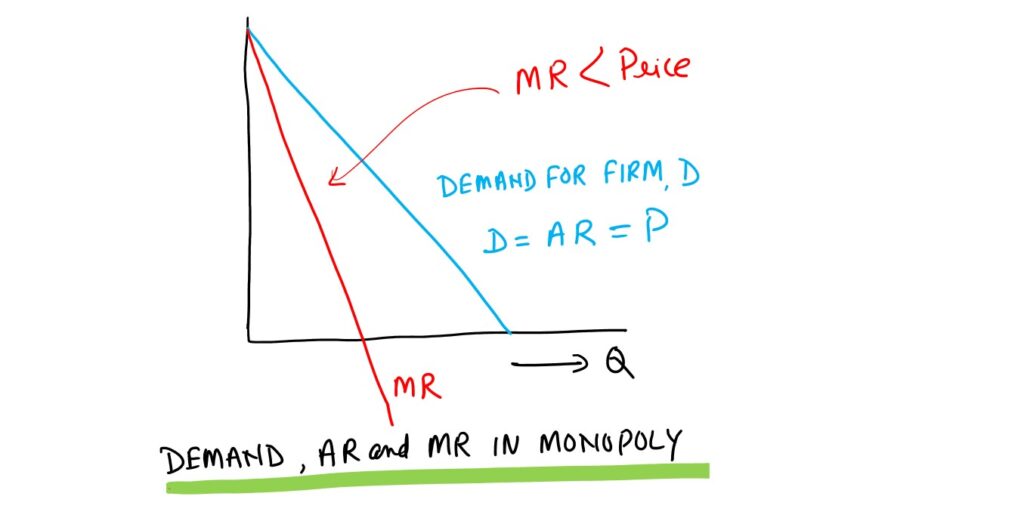Features of Monopoly
What is Monopoly
A monopoly is a market structure characterized by the dominance of a single seller or producer who has a significant degree of control over the supply and pricing of a particular product or service. There are no close substitutes available for the product, and entry into the market by potential competitors is restricted due to various barriers.

Examples:
Microsoft: Microsoft has held a monopoly in the operating system market with its Windows operating system for many years.
De Beers: The diamond mining company De Beers has historically had a monopoly on the diamond industry, controlling the majority of diamond production and distribution.
Demand in Monopoly
In a monopoly market, the demand curve faced by the monopolist is the market demand curve. Unlike in a competitive market where the demand curve is perfectly elastic, the demand curve for a monopolist is downward sloping. This means that as the monopolist increases the price of its product, the quantity demanded decreases, and vice versa. The monopolist has the power to set the price of the product based on its assessment of consumer demand and willingness to pay.

Price in Monopoly
The monopolist has the ability to set the price of its product since it is the sole supplier in the market. Unlike in competitive markets where price is determined by the forces of supply and demand, in a monopoly, the monopolist sets the price at a level that maximizes its profits. This price is typically higher than the marginal cost of production, allowing the monopolist to earn economic profits in the long run.
Average Revenue of Monopoly
Average revenue (AR) in a monopoly refers to the revenue earned by the monopolist per unit of output sold. Since the monopolist is the only seller in the market, the average revenue is equal to the price of the product. The average revenue curve for a monopolist is downward sloping, reflecting the fact that as the monopolist sells more units of its product, it must lower the price in order to attract additional customers.
Marginal Revenue of Monopoly
Marginal revenue (MR) in a monopoly refers to the change in total revenue that results from selling one additional unit of output. Unlike in competitive markets where marginal revenue equals the price of the product, in a monopoly, marginal revenue is less than the price. This is because the monopolist must lower the price of all units sold in order to sell an additional unit, leading to a decrease in total revenue. The marginal revenue curve for a monopolist is below the demand curve and downward sloping. In fact, the marginal revenue curve intersects the horizontal axis at a point where demand is elastic, and beyond that point, marginal revenue becomes negative.
Examples: Let’s consider a hypothetical monopolist selling widgets. If the monopolist is currently selling 10 widgets at a price of Rs 20 each, and it decides to lower the price to Rs 19 to sell an additional widget, the total revenue from selling the 11th widget would be Rs 19 (the new price) multiplied by 11 (the quantity sold), which equals Rs 209. The marginal revenue from selling the 11th widget would then be Rs 209 (total revenue from selling 11 widgets) minus Rs 200 (total revenue from selling 10 widgets at Rs 20 each), which equals Rs 9.
In conclusion, monopoly markets are characterized by a single seller with significant market power, allowing them to set prices above marginal cost and earn economic profits. The demand curve faced by a monopolist is downward sloping, and the monopolist has the ability to set the price of its product. Both average revenue and marginal revenue curves are downward sloping, with marginal revenue always less than price or average revenue.
UGC NET Previous Years Questions- Features of Monopoly
1. Assertion ‘A’: A monopoly firm’s revenue curve is downward sloping from left to right.
Reason ‘R’: The monopoly firm does not simultaneously enjoy the freedom to determine both price and quantity to be sold according to its whims and fancy. (UGC NET Commerce Jun 2014)
A. Both ‘A’ and ‘R’ are true.
B. Both ‘A’ and ‘R’ are false.
C. ‘A’ is true, but ‘R’ is false.
D. ‘A’ is false, but ‘R’ is true
Ans. A
2. A market structure which consists of one buyer and one seller is referred as (UGC NET Management Dec 2012)
A. Monopsony
B. Bilateral monopoly
C. Monopoly
D. Duopoly
Ans. B
3. Which one of the following statements is correct? (UGC NET Commerce Dec 2009)
A. Monopolist charges the maximum possible price.
B. Monopolist always makes (economic) profit.
C. Monopolist operates on an inelastic demand curve.
D. None of the above
Ans. B



